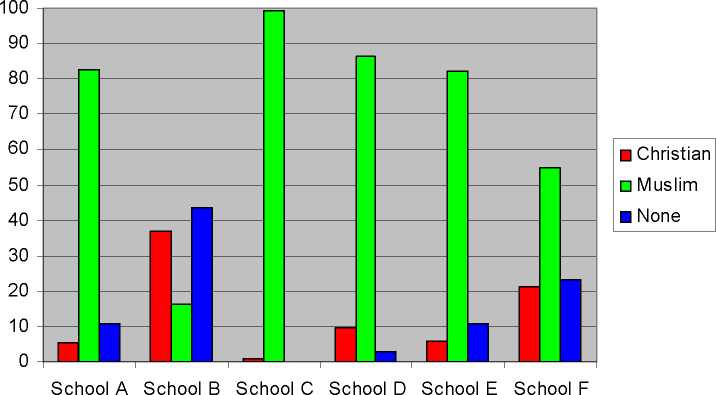2.
Sample by Religion in Schools

|
Religions |
Christian |
Religion |
None | |||
|
N__ |
% |
N |
% |
N |
% | |
|
School A |
10 |
5.6 |
147 |
82.6 |
19 |
10.7 |
|
School B |
44 |
37 |
19 |
16 |
52 |
43.7 |
|
School C |
1 |
0.9 |
115 |
99.1 |
0 |
0 |
|
School D |
22 |
9.4 |
203 |
86.4 |
7 |
3 |
|
School E |
7 |
5.7 |
101 |
82.1 |
13 |
10.6 |
|
School F |
44___ |
21 |
115___ |
54.8 |
49 |
23.2 |
|
Total |
128___ |
12.6 |
700___ |
69.1 |
140 |
13.8 |
Islam is the predominant religion in the research sample at 69% while 13% were
Christian and 14% had no religion. 33 students did not give information about their
religion. Most schools are majority Muslim except School B, which is a suburban school
rather than an inner city school.
‘I go to mosque five times a week. I never miss it. It’s very important to me.’
‘I only go to church for weddings and funerals. My mum used to be a Catholic but she
doesn’t really go to church now.’
64
More intriguing information
1. The name is absent2. Place of Work and Place of Residence: Informal Hiring Networks and Labor Market Outcomes
3. Evaluation of the Development Potential of Russian Cities
4. The name is absent
5. ENERGY-RELATED INPUT DEMAND BY CROP PRODUCERS
6. CAN CREDIT DEFAULT SWAPS PREDICT FINANCIAL CRISES? EMPIRICAL STUDY ON EMERGING MARKETS
7. Plasmid-Encoded Multidrug Resistance of Salmonella typhi and some Enteric Bacteria in and around Kolkata, India: A Preliminary Study
8. Job quality and labour market performance
9. The name is absent
10. Initial Public Offerings and Venture Capital in Germany